Drought Assessment in a Semi-Arid River Basin in China and its Sensitivity to Different Evapotranspiration Models
Abstract
1. Introduction
2. Study Area and Methods
2.1. Study Area and Data Description
2.2. SPEI and Drought Characteristics
2.3. Calculations of PET
3. Results and Analysis
3.1. Drought Assessment over the Study Area
3.1.1. Drought Events
3.1.2. Drought Characteristics
3.2. Comparison of PET Models
3.3. Effects of Different PET Models to SPEI
3.3.1. SPEI Differences from Various PET Models
3.3.2. SPEI Correlation Analysis
3.3.3. Drought Events
3.3.4. Drought Characteristics
4. Conclusions
Author Contributions
Funding
Acknowledgments
Conflicts of Interest
References
- Heim, R.R. A review of twentieth-century drought indices used in the United States. Bull. Am. Meteorol. Soc. 2002, 83, 1149–1165. [Google Scholar] [CrossRef]
- American Meteorological Society. Meteorological drought—Policy Statement. Bull. Am. Meteorol. Soc. 1997, 78, 847–849. [Google Scholar] [CrossRef]
- American Meteorological Society. Statement on Meteorological Drought. Bull. Am. Meteorol. Soc. 2004, 85, 771–773. [Google Scholar]
- Zhang, A.Z.; Jia, G.S. Monitoring meteorological drought in semiarid regions using multi-sensor microwave remote sensing data. Remote Sens. Environ. 2013, 134, 12–23. [Google Scholar] [CrossRef]
- Wilhite, D.A. Preparing for drought: A methodology. In Drought: A Global Assessment; Routledge: London, UK, 2000; pp. 89–104. [Google Scholar]
- Mishra, A.K.; Singh, V.P. Analysis of drought severity-area-frequency curves using a general circulation model and scenario uncertainty. J. Geophys. Res. Atmos. 2009, 114, 120–137. [Google Scholar] [CrossRef]
- Su, X.L.; Vijay, P.S.; Niu, J.P.; Hao, L. Spatiotemporal trends of aridity index in Shiyang River basin of northwest China. Stoch. Environ. Res. Risk Assess. 2015, 29, 1571–1582. [Google Scholar] [CrossRef]
- Chang, Z.F.; Liu, H.J. Integrated control of desertification in Hexi continental river valley in Gansu. Protec Forest Sci. Tec. 2003, 1, 19–23. [Google Scholar] [CrossRef]
- Gibbs, W.J.; Maher, J.V. Rainfall Deciles as Drought Indicators. Melbourne, Australia, 1967; 39p. Available online: http://lccn.loc.gov/map68000376 (accessed on 5 November 2018).
- Hao, Z.; AghaKouchak, A. Multivariate standardized drought Index: A parametric multi-index model. Adv. Water Resour. 2013, 57, 12–18. [Google Scholar] [CrossRef]
- Palmer, W.C. Meteorological Drought; Research Paper; U.S. Department of Commerce Weather Bureau: Washington, DC, USA, 1965.
- McKee, T.B.; Doesken, N.J.; Kleist, J. The relationship of drought frequency and duration to time scales. Eight Conference on Applied Climatology; American Meteorological Society: Anaheim, CA, USA, 1993; pp. 179–184. [Google Scholar]
- Vicente-Serrano, S.M.; Beguería, S.; Lópz-Moreno, J.I. A multi-scalar drought index sensitive to global warming: The standardized precipitation evapotranspiration index-SPEI. J. Clim. 2010, 23, 1696–1718. [Google Scholar] [CrossRef]
- Abiodun, B.J.; Salami, A.T.; Matthew, O.J.; Odedokun, S. Potential impacts of afforestation on climate change and extreme events in Nigeria. Clim. Dyn. 2013, 41, 277–293. [Google Scholar] [CrossRef]
- Yu, M.; Li, G.; Hayes, M.J.; Svoboda, M.; Heim, R.R. Are droughts becoming more frequent or severe in China based on the standardized precipitation evapotranspiration index: 1951–2010? J. Clim. 2013, 34, 545–558. [Google Scholar] [CrossRef]
- Li, B.Q.; Zhou, W.; Zhao, Y.Y.; Ju, Q.; Yu, Z.; Liang, Z.; Acharya, K. Using the SPEI to Assess Recent Climate Change in the Yarlung Zangbo River Basin, South Tibet. Water 2015, 7, 5474–5486. [Google Scholar] [CrossRef]
- Byakatonda, J.; Parida, B.P.; Kenabatho, P.K.; Moalafhi, D.B. Influence of climate variability and length of rainy season on crop yields in semiarid Botswana. Agric. Forest Meteorol. 2018, 248, 130–144. [Google Scholar] [CrossRef]
- McEvoy, D.J.; Huntington, J.L.; Abatzoglou, J.T.; Edwards, L.M. An evaluation of multiscalar drought indices in Nevada and eastern California. Earth Interact. 2012, 16, 1–18. [Google Scholar] [CrossRef]
- Zareabyaneh, H.; Ghobaeisoogh, M.; Mosaedi, A. Drought Monitoring Based on Standardized Precipitation Evaoptranspiration Index (SPEI) Under the Effect of Climate Change. Majallah-iāb va Khāk. 2016, 29, 374–392. [Google Scholar] [CrossRef]
- Miah, M.G.; Abdullah, H.M.; Jeong, C. Exploring standardized precipitation evapotranspiration index for drought assessment in Bangladesh. Environ. Monit. Assess. 2017, 189, 547. [Google Scholar] [CrossRef] [PubMed]
- Jia, Y.Q.; Zhang, B.; Ma, B. Daily SPEI Reveals Long-term Change in Drought Characteristics in Southwest China. Chin. Geogr. Sci. 2018, 28, 680–693. [Google Scholar] [CrossRef]
- Wang, F.; Wang, Z.M.; Yang, H.B.; Zhao, Y. Study of the temporal and spatial patterns of drought in the Yellow River basin based on SPEI. Sci. China-Earth Sci. 2018. [Google Scholar] [CrossRef]
- Thornthwaite, C.W. An approach toward a rational classification of climate. Geogr. Rev. 1948, 38, 55–94. [Google Scholar] [CrossRef]
- Donohue, R.J.; McVicar, T.R.; Roderick, M.L. Assessing the ability of potential evaporation equations to capture the dynamics in evaporative demand within a changing climate. J. Hydrol. 2010, 386, 186–197. [Google Scholar] [CrossRef]
- Van der Schrier, G.; Jones, P.D.; Briffa, K.R. The sensitivity of the PDSI to the Thornthwaite and Penman-Monteith parameterizations for potential evapotranspiration. J. Geophys. Res. 2011, 116, D03106. [Google Scholar] [CrossRef]
- Sheffield, J.; Wood, E.F.; Roderick, M.L. Little change in global drought over the past 60 years. Nature 2012, 491, 435–438. [Google Scholar] [CrossRef] [PubMed]
- Jensen, M.E.; Burman, R.D.; Allen, R.G. Evapotranspiration and Irrigation Water Requirements; ASCE Manuals and Reports on Engineering Practices No. 70; American Society Civil Engineers: New York, NY, USA, 1990. [Google Scholar]
- Homdee, T.; Pongput, K.; Kanae, S. A comparative performance analysis of three standardized climatic drought indices in the Chi River basin, Thailand. Agric. Nat. Res. 2016, 50, 211–219. [Google Scholar] [CrossRef]
- Allen, G.R.; Pereira, L.S.; Raes, D.; Smith, M. Crop Evapotranspiration: Guidelines for Computing Crop Water Requirement; FAO Irrigation and Drainage Paper 56; FAO: Rome, Italy, 1998; pp. 78–86. [Google Scholar]
- Beguería, S.; Vicente-Serrano, S.M.; Reig, F.; Latorre, B. Standardized precipitation evapotranspiration index (SPEI) revisited: Parameter fitting, evapotranspiration models, tools, datasets and drought monitoring. Int. J. Clim. 2014, 34, 3001–3023. [Google Scholar] [CrossRef]
- Yuan, S.S.; Quiring, S.M. Drought in the U.S. Great Plains (1980–2012): A sensitivity study using different methods for estimating potential evapotranspiration in the Palmer Drought Severity Index. J. Geophys. Res. 2014, 119, 10,996–11,010. [Google Scholar] [CrossRef]
- Zhang, B.Q.; Wang, Z.K.; Chen, G. A Sensitivity Study of Applying a Two-Source Potential Evapotranspiration Model in the Standardized Precipitation Evapotranspiration Index for Drought Monitoring. Land Degrad. Dev. 2016, 28, 783–793. [Google Scholar] [CrossRef]
- Zhou, D.; Zhang, B.; Shen, Y.J. Effect of Potential Evapotranspiration Estimation Method on Reconnaissance Drought Index (RDI) Calculation. J. Agrometeorol. 2014, 35, 258–267. [Google Scholar] [CrossRef]
- Valipour, M. Study of different climatic conditions to assess the role of solar radiation in reference crop evapotranspiration equations. Arch. Agron. Soil Sci. 2015, 61, 679–694. [Google Scholar] [CrossRef]
- Wang, G.; Gong, T.; Lu, J.; Lou, D.; Hagan, D.F.T.; Chen, T. On the long-term changes of drought over China (1948–2012) from different methods of potential evapotranspiration estimations. Int. J. Clim. 2018, 38, 2954–2966. [Google Scholar] [CrossRef]
- Um, M.J.; Kim, Y.; Park, D.; Kim, J. Effects of different reference periods on drought index (SPEI) estimations from 1901 to 2014. Hydrol. Earth Syst. Sci. 2017, 21, 4989–5007. [Google Scholar] [CrossRef]
- Chinese Academy of Meteorological Sciences, National Meteorological Center, Department of Forecasting Services and Disaster Mitigation at CMA. Classification of Meteorological Drought; GB/T20481-2006; Standards Press of China: Beijing, China, 2006. [Google Scholar]
- Yevjevich, V. An objective approach to definitions and investigations of continental hydrologic droughts. In Proceedings of the Conference on the Recent Drought in the Northeastern United States, Sterling Forest, NY, USA, 15–17 May 1967; Available online: https://mountainscholar.org/bitstream/handle/10217/61303/HydrologyPapers_n23.pdf?sequence=1&isAllowed=y (accessed on 24 December 2018).
- Xu, C.Y.; Singh, V.P. Evaluation and generalization of temperature based methods for calculating evaporation. Hydrol. Process 2001, 15, 305–319. [Google Scholar] [CrossRef]
- Blaney, H.F.; Criddle, W.D. Determining Water Requirements in Irrigated Areas from Climatological Irrigation Data; Technical Paper No. 96; US Department of Agriculture, Soil Conservation Service: Washington, DC, USA, 1950; 48p.
- Hargreaves, G.L.; Samani, Z.A. Reference crop evapotranspiration from temperature. Appl. Eng. Agric. 1985, 1, 96–99. [Google Scholar] [CrossRef]
- Kharrufa, N.S. Simplified equation for evapotranspiration in arid regions. Beiträge zur Hydrologie Sonderheft 1985, 5, 39–47. [Google Scholar]
- Hamon, W.R. Estimating potential evapotranspiration. J. Hydraul. Divis. 1961, 87, 107–120. [Google Scholar]
- Rácz, C.; NAGY, J.; Dobos, A.C. Comparison of Several Methods for Calculation of Reference Evapotranspiration. Acta Silvatica et Lignaria Hungarica 2013, 9, 9–24. [Google Scholar] [CrossRef]
- Makkink, G.F. Testing the Penman formula by means of lysimeters. J. Inst. Water Engineers 1975, 11, 277–288. [Google Scholar]
- Hargreaves, G.H. Moisture availability and crop production. Trans. ASAE 1975, 18, 980–984. [Google Scholar] [CrossRef]
- Abtew, W. Evapotranspiration measurements and modeling for three wetland systems in south florida. J. Am. Water Resour. Assoc. 1996, 32, 9. [Google Scholar] [CrossRef]
- Priestley, C.; Taylor, R. On the assessment of surface heat flux and evaporation using large-scale parameters. Mon. Weather Rev. 1972, 100, 81–92. [Google Scholar] [CrossRef]
- Penman, H.L. Natural evaporation from open water, bare soil and grass. Proceedings of the Royal Society of London. A-Math. Phys. Sci. 1948, 193, 120–145. [Google Scholar] [CrossRef]
- Li, Z.L.; Xu, Z.X.; Li, J.Y.; Li, Z.L. Shift trend and step changes for runoff time series in the Shiyang River basin, northwest China. Hydrol. Processes 2008, 22, 4639–4646. [Google Scholar] [CrossRef]
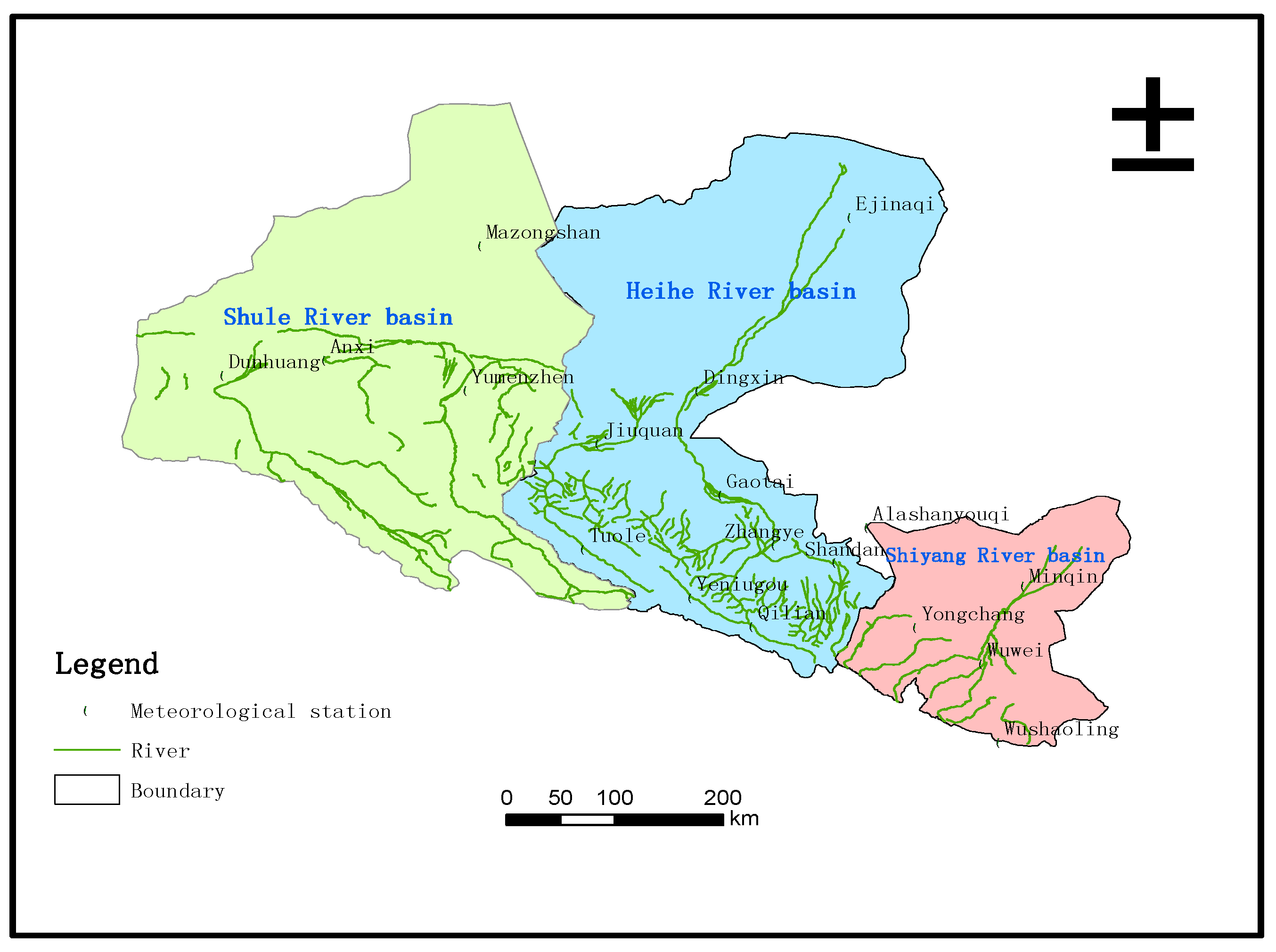
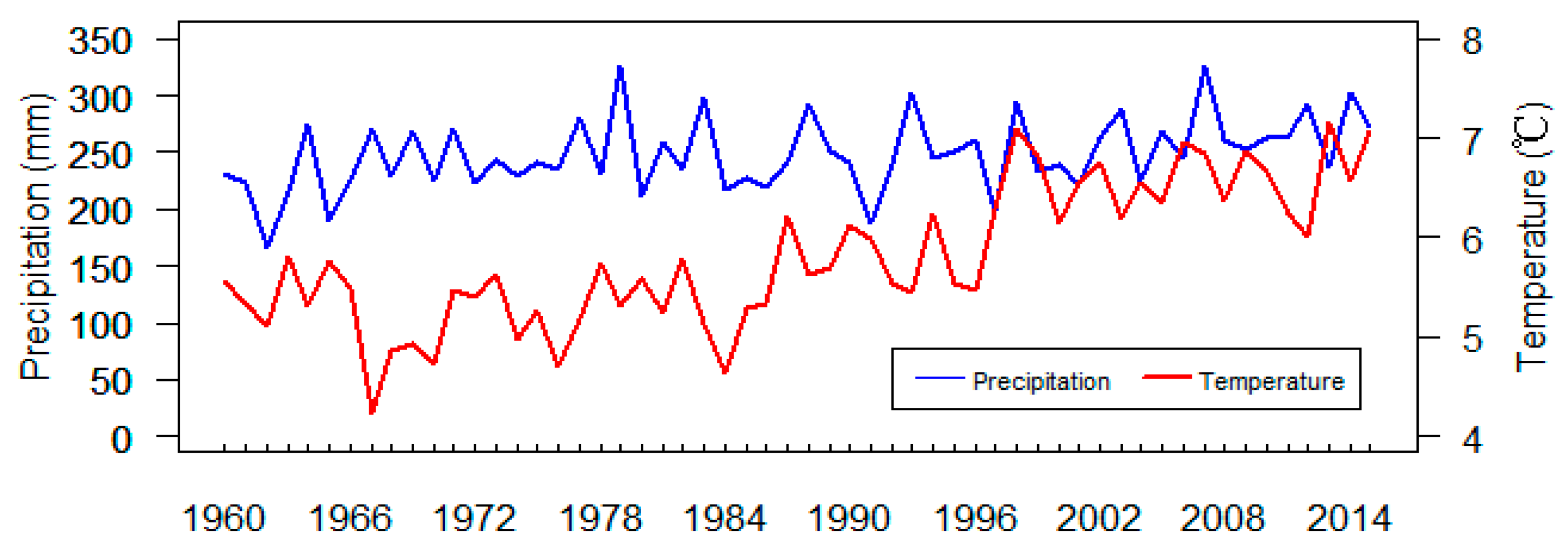



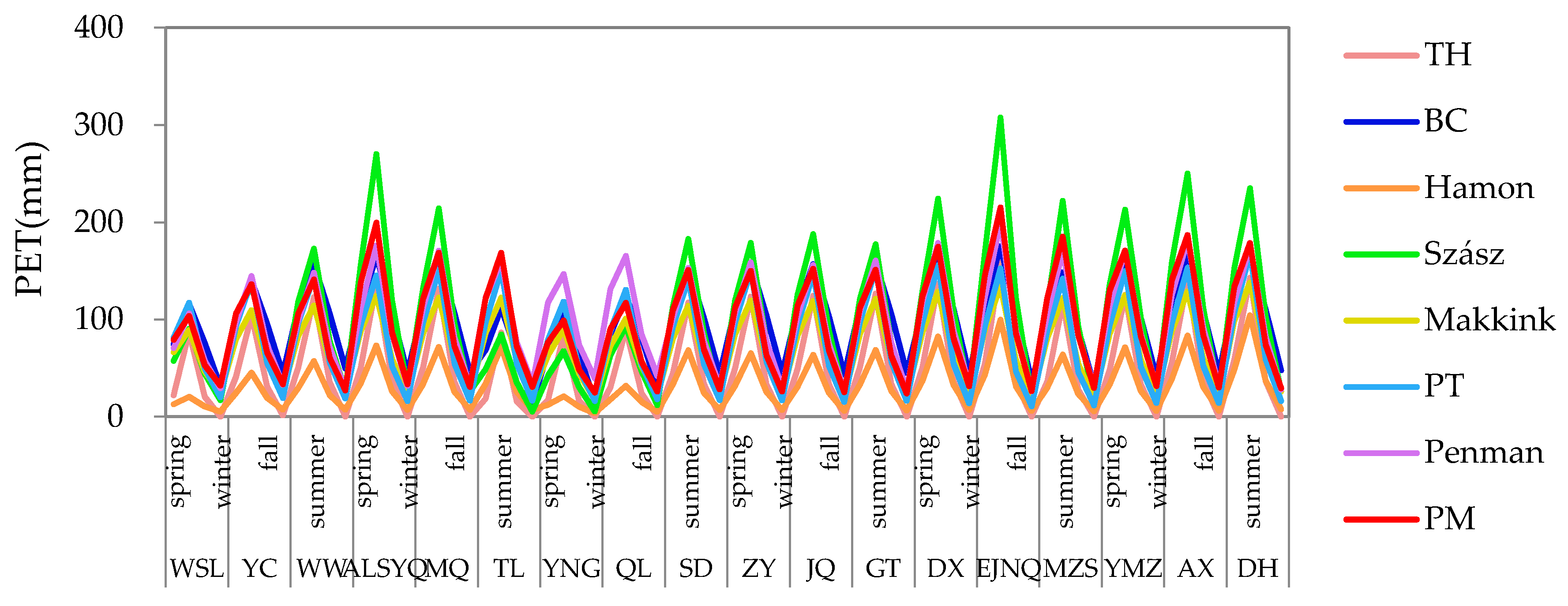
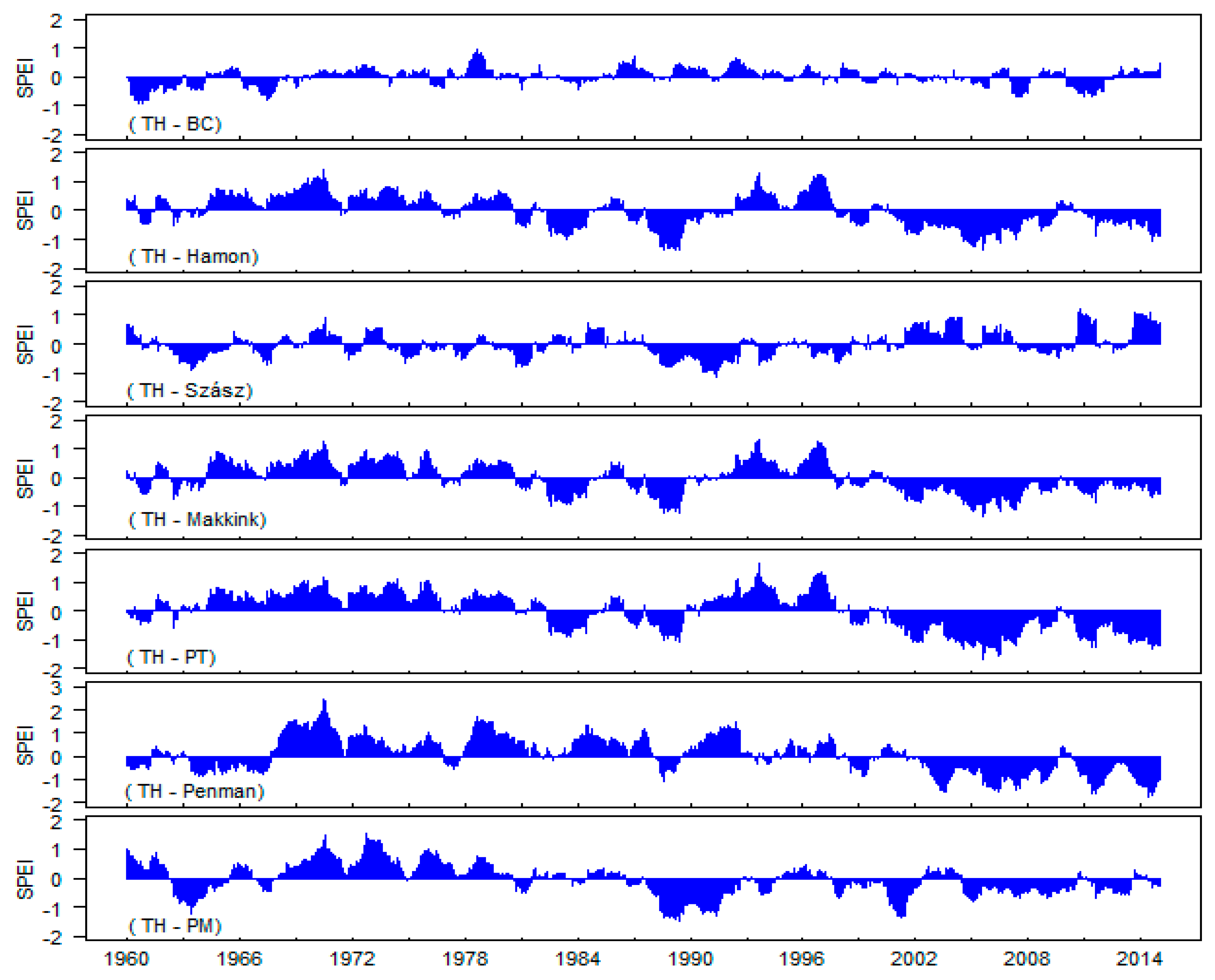

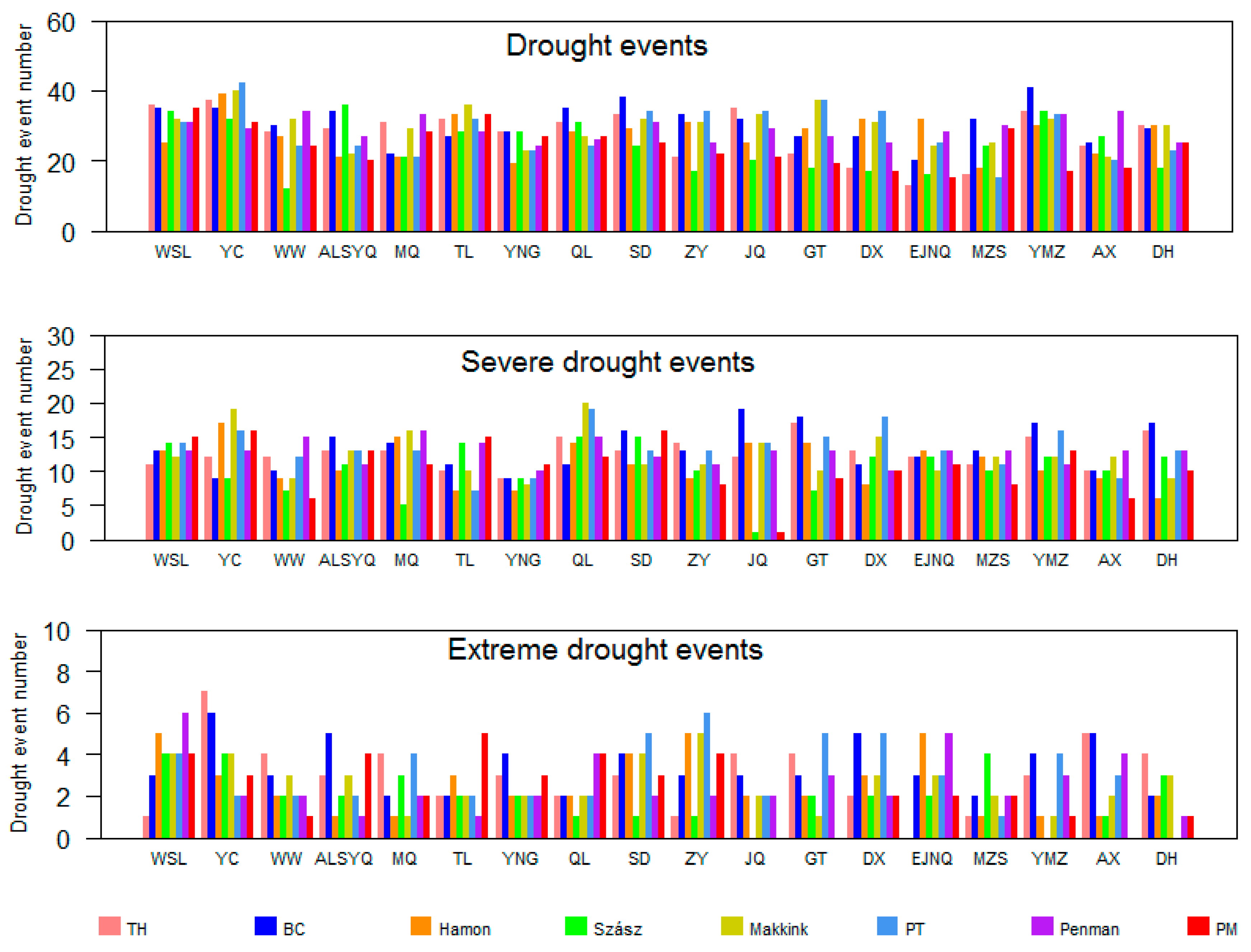

| No. | Basin | Station | Longitude | Latitude | Elevation (mm) | Annual Precipitation (mm) | Annual Mean Temperature (°C) |
|---|---|---|---|---|---|---|---|
| 1 | Shiyang River Basin (SYRB) | Wushaoling (WSL) | 102.52 | 37.12 | 3045.1 | 403.5 | 1.28 |
| 2 | Yongchang (YC) | 101.56 | 38.13 | 1976.9 | 199.6 | 5.14 | |
| 3 | Wuwei (WW) | 102.40 | 37.55 | 1531.5 | 166.0 | 8.26 | |
| 4 | Alashanyouqi (ALSYQ) | 101.41 | 39.13 | 1510.1 | 117.8 | 8.88 | |
| 5 | Minqin (MQ) | 103.05 | 38.38 | 1367.5 | 114.1 | 8.45 | |
| 6 | Heihe River Basin (HRB) | Tuole (TL) | 98.25 | 38.48 | 3367.0 | 298.0 | −2.54 |
| 7 | Yeniugou (YNG) | 99.36 | 38.26 | 3320.0 | 417.5 | −2.84 | |
| 8 | Qilian (QL) | 100.15 | 38.11 | 2787.4 | 409.3 | 1.13 | |
| 9 | Shandan (SD) | 101.05 | 38.48 | 1764.6 | 200.6 | 6.55 | |
| 10 | Zhangye (ZY) | 100.17 | 39.05 | 1482.7 | 127.8 | 7.48 | |
| 11 | Jiuquan(JQ) | 98.29 | 39.46 | 1477.2 | 86.3 | 7.56 | |
| 12 | Gaotai (GT) | 99.50 | 39.22 | 1332.2 | 107.8 | 7.93 | |
| 13 | Dingxin (DX) | 99.31 | 40.18 | 1177.4 | 55.2 | 8.47 | |
| 14 | Erjinaqi (EJNQ) | 101.04 | 41.57 | 940.5 | 35.2 | 9.01 | |
| 15 | Shule River Basin (SLRB) | Mazongshan (MZS) | 97.02 | 41.48 | 1770.4 | 72.8 | 4.46 |
| 16 | Yumenzhen (YMZ) | 97.02 | 40.16 | 1526.0 | 65.9 | 7.24 | |
| 17 | Anxi (AX) | 95.47 | 40.32 | 1170.9 | 47.0 | 9.03 | |
| 18 | Dunhuang (DH) | 94.41 | 40.09 | 1139.0 | 38.9 | 9.70 |
| Level | Type | SPEI |
|---|---|---|
| 1 | None | >−0.5 |
| 2 | Light drought | (−1, −0.5] |
| 3 | Moderate drought | (−1.5, −1] |
| 4 | Severe drought | (−2, −1.5] |
| 5 | Extreme drought | ≤−2 |
| Type | Name | Equation | Input Data |
|---|---|---|---|
| Temperature-based | Thornthwaite (TH) | : monthly mean temperature : estimated by an I-related third-orderpolynomial : empirical coefficient with value of 16 | |
| Blaney–Criddle (BC) | : mean daily temperature : mean daily percentage of annual daytime hours k: empirical coefficient with values between 0.5 and 1.2, the initial value is 0.85 | ||
| Hamon | : mean daily temperature : average number of daylight hours per day : saturation vapor pressure | ||
| Szász | = 0.0053 : mean daily temperature RH: mean daily relative humidity : mean daily wind speed at 2 m height | RH | |
| Radiation-based | Makkink | : net daily radiation to the evaporating surface : the slope of the vapor pressure curve at air temperature : the psychrometric constant λ: the latent heat of vaporization empirical coefficients, | |
| Priestley–Taylor (PT) | : the net daily radiation at the evaporating surface ∆: the slope of the vapor pressure curve at air temperature : the psychrometric constant λ: the latent heat of vaporization : the Priestley–Taylor constant with value of 1.26 | ||
| Combination | Penman | : the net daily radiation to the evaporating surface : a function of the average daily wind speed, saturation vapor pressure, and average vapor pressure ∆: the slope of the vapor pressure curve at air temperature : the psychrometric constant λ: the latent heat of vaporization | |
| Penman–Monteith (PM) | : net radiation : monthly mean temperature : wind speed Δ: slope of the vapor pressure curve G: soil heat flux : vapor pressure deficit : psychometric constant |
| Station | Number of Drought Events | ||
|---|---|---|---|
| Total | Severe | Extreme | |
| WSL | 36 (14, 39%) | 11 (7, 64%) | 1 (1, 100%) |
| YC | 37 (12, 32%) | 12 (6, 50%) | 7 (5, 71%) |
| WW | 28 (14, 50%) | 12 (10, 83%) | 4 (4, 100%) |
| ALSYQ | 29 (13, 45%) | 13 (8, 62%) | 3 (2, 67%) |
| MQ | 31 (13, 42%) | 13 (10, 77%) | 4 (2, 50%) |
| TL | 32 (12, 38%) | 10 (0, 0%) | 2 (0, 0%) |
| YNG | 28 (9, 32%) | 9 (3, 33%) | 3 (1, 33%) |
| QL | 31 (10, 32%) | 15 (8, 53%) | 2 (2, 100%) |
| SD | 33 (10, 30%) | 13 (6, 46%) | 3 (2, 67%) |
| ZY | 21 (10, 48%) | 14 (12, 86%) | 1 (1, 100%) |
| JQ | 35 (16, 46%) | 12 (8, 67%) | 4 (2, 50%) |
| GT | 22 (12, 55%) | 17 (16, 94%) | 4 (4, 100%) |
| DX | 18 (9, 50%) | 13 (11, 85%) | 2 (2, 100%) |
| EJNQ | 13 (5, 38%) | 12 (12, 100%) | 0 (0, 0%) |
| MZS | 16 (8, 50%) | 11 (10, 91%) | 1 (1, 100%) |
| YMZ | 34 (16, 47%) | 15 (10, 67%) | 3 (3, 100%) |
| AX | 24 (15, 63%) | 10 (10, 100%) | 5 (5, 100%) |
| DH | 30 (15, 50%) | 16 (15, 94%) | 4 (4, 100%) |
| Station | PET Models | |||||||
|---|---|---|---|---|---|---|---|---|
| TH | BC | Hamon | Szász | Makkink | PT | Penman | PM | |
| WSL | 5.33 * | −0.18 | 4.30 * | 5.33 * | 5.18 * | 6.00 * | 6.97 * | 5.59 * |
| YC | −4.20 * | −4.69 * | −2.98 * | −5.46 * | −2.67 * | −0.59 | 1.14 | −3.84 * |
| WW | −8.23 * | −6.69 * | −3.85 * | −7.13 * | −2.92 * | −1.18 | −1.79 | −3.18 * |
| ALSYQ | −5.53 * | −2.93 * | −3.80 * | 0.40 | −3.20 * | 1.10 | 0.09 | 3.56 * |
| MQ | −4.44 * | −6.53 * | −4.15 * | −4.69 * | −3.86 * | −7.82 * | −0.20 | −0.11 |
| TL | 1.27 | 0.15 | 1.14 | 0.24 | 2.33 * | 2.11 * | 4.12 * | 0.95 |
| YNG | −1.48 | −2.95 * | −1.96 * | 0.64 | −2.45 * | −2.46 * | 0.02 | −0.49 |
| QL | −2.36 * | −3.84 * | −0.66 | −3.41 * | −2.25 * | −2.55 * | −1.83 | 1.06 |
| SD | −3.12 * | −3.40 * | 0.69 | −1.61 | −0.63 | −0.23 | −0.41 | 2.02 * |
| ZY | −5.89 * | −3.58 * | 1.17 | −11.04 * | 0.86 | −0.16 | 2.31 * | −7.58 * |
| JQ | −1.44 | −2.49 * | −3.48 * | −3.97 * | −3.50 * | −0.83 | 3.46 * | 2.47 * |
| GT | −6.32 * | −4.75 * | 0.20 | −9.08 * | 0.90 | 2.27 * | 1.93 | −1.65 |
| DX | −6.08 * | −4.64 * | −3.66 * | −6.38 * | −2.97 * | −1.74 | 0.72 | −0.71 |
| EJNQ | −2.91 * | −4.67 * | −0.16 | −4.70 * | −4.71 * | 6.05 * | −3.70 * | −1.98 * |
| MZS | −2.98 * | −2.52 * | −7.59 * | −5.80 * | −6.77 * | −5.41 * | −3.65 * | −4.87 * |
| YMZ | −3.82 * | −2.67 * | 1.44 | 1.38 | 3.87 * | 2.74 * | 3.57 * | 2.08 * |
| AX | −4.82 * | −3.92 * | 0.03 | 1.27 | 6.75 * | 5.21 * | 3.71 * | −2.56 * |
| DH | −5.15 * | −6.80 * | 0.91 | 0.91 | −7.28 * | −0.63 | 3.21 * | 1.09 |
| No. | 16 | 17 | 10 | 11 | 12 | 11 | 6 | 10 |
| Station | TH | BC | Hamon | Szász | Makkink | PT | Penman | PM |
|---|---|---|---|---|---|---|---|---|
| WSL | 388 | 890 | 148 | 626 | 681 | 807 | 790 | 804 |
| YC | 532 | 1135 | 148 | 987 | 803 | 908 | 1045 | 1006 |
| WW | 628 | 1276 | 348 | 1187 | 840 | 950 | 1041 | 998 |
| ALSYQ | 672 | 1290 | 421 | 1724 | 886 | 922 | 1211 | 1373 |
| MQ | 654 | 1284 | 414 | 1404 | 872 | 960 | 1187 | 1177 |
| TL | 361 | 777 | 179 | 521 | 705 | 836 | 873 | 780 |
| YNG | 351 | 765 | 141 | 435 | 644 | 785 | 853 | 746 |
| QL | 432 | 961 | 210 | 646 | 743 | 872 | 930 | 870 |
| SD | 585 | 1209 | 398 | 1209 | 823 | 915 | 1089 | 1071 |
| ZY | 619 | 1251 | 390 | 1186 | 859 | 963 | 1119 | 1056 |
| JQ | 621 | 1243 | 375 | 1272 | 845 | 930 | 1082 | 1070 |
| GT | 633 | 1269 | 407 | 1187 | 864 | 972 | 1116 | 1047 |
| DX | 671 | 1290 | 480 | 1461 | 898 | 965 | 1257 | 1233 |
| EJNQ | 743 | 1304 | 538 | 1856 | 898 | 907 | 1313 | 1415 |
| MZS | 543 | 1092 | 368 | 1334 | 826 | 863 | 1171 | 1266 |
| YMZ | 618 | 1221 | 411 | 1420 | 872 | 931 | 1203 | 1240 |
| AX | 700 | 1321 | 472 | 1635 | 891 | 947 | 1295 | 1309 |
| DH | 713 | 1343 | 587 | 1550 | 987 | 1050 | 1211 | 1244 |
| Average | 581 | 1162 | 358 | 1202 | 830 | 916 | 1099 | 1095 |
© 2019 by the authors. Licensee MDPI, Basel, Switzerland. This article is an open access article distributed under the terms and conditions of the Creative Commons Attribution (CC BY) license (http://creativecommons.org/licenses/by/4.0/).
Share and Cite
Zhang, D.; Li, Z.; Tian, Q.; Feng, Y. Drought Assessment in a Semi-Arid River Basin in China and its Sensitivity to Different Evapotranspiration Models. Water 2019, 11, 1061. https://doi.org/10.3390/w11051061
Zhang D, Li Z, Tian Q, Feng Y. Drought Assessment in a Semi-Arid River Basin in China and its Sensitivity to Different Evapotranspiration Models. Water. 2019; 11(5):1061. https://doi.org/10.3390/w11051061
Chicago/Turabian StyleZhang, Dan, Zhanling Li, Qingyun Tian, and Yaru Feng. 2019. "Drought Assessment in a Semi-Arid River Basin in China and its Sensitivity to Different Evapotranspiration Models" Water 11, no. 5: 1061. https://doi.org/10.3390/w11051061
APA StyleZhang, D., Li, Z., Tian, Q., & Feng, Y. (2019). Drought Assessment in a Semi-Arid River Basin in China and its Sensitivity to Different Evapotranspiration Models. Water, 11(5), 1061. https://doi.org/10.3390/w11051061





